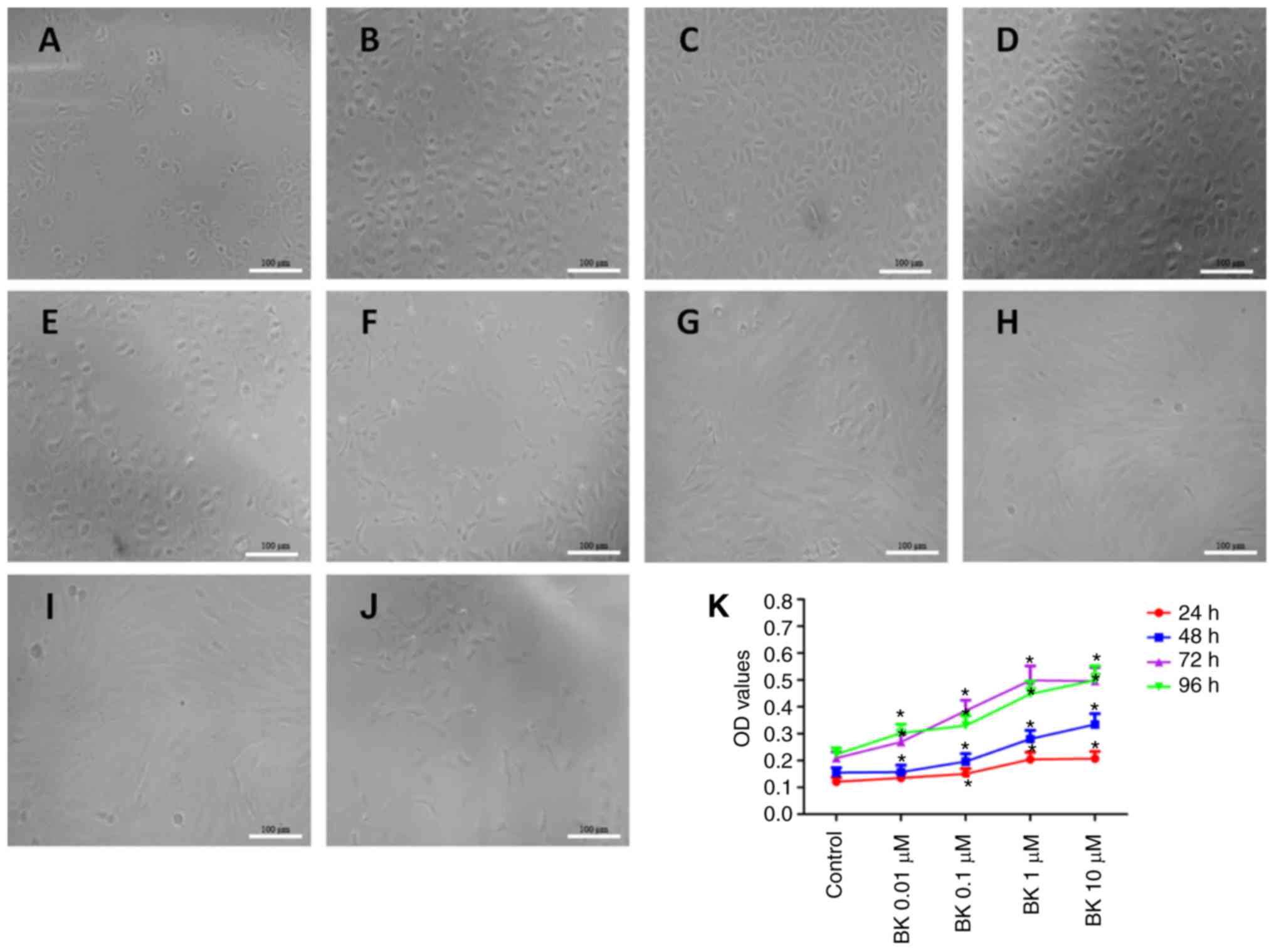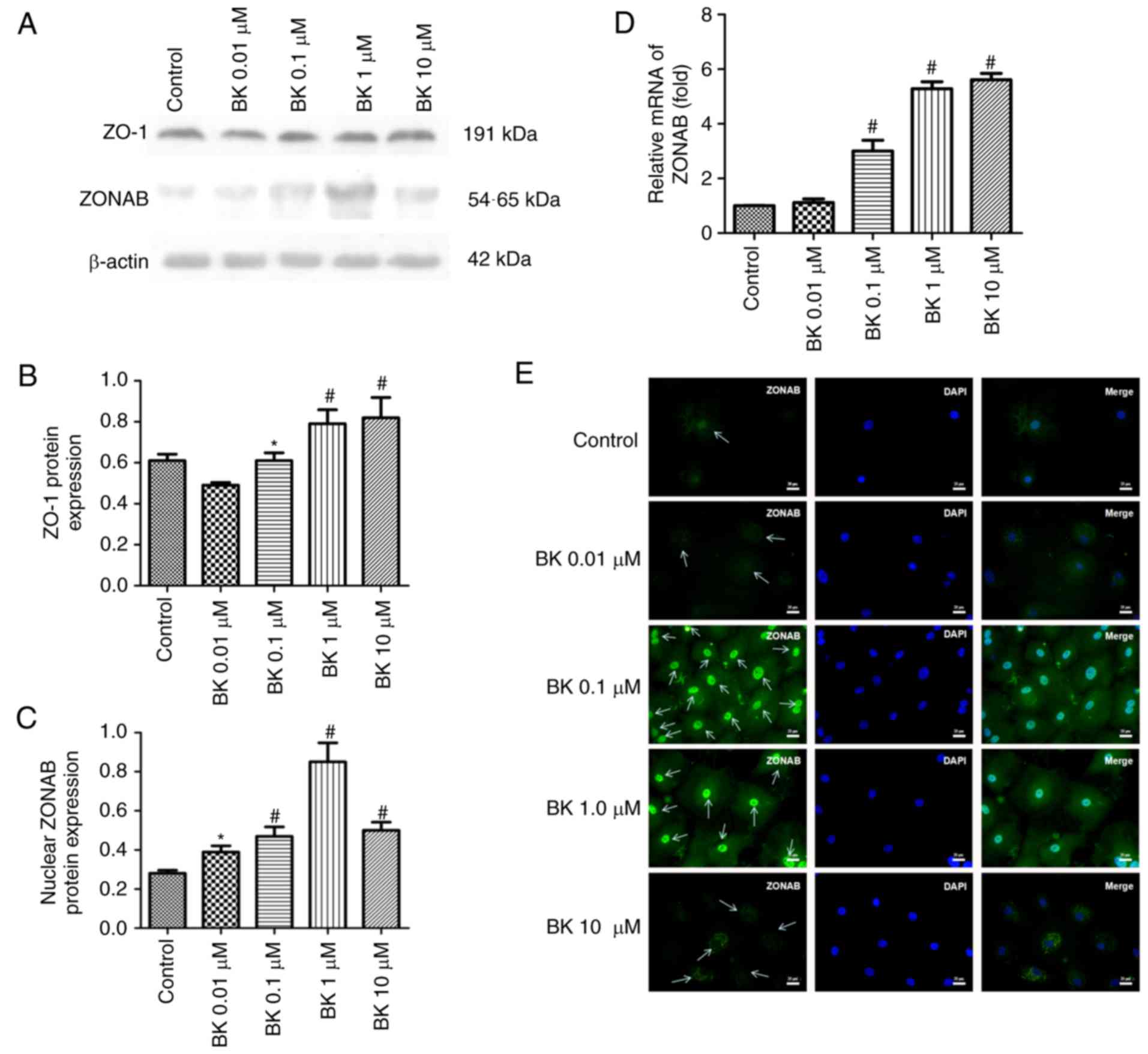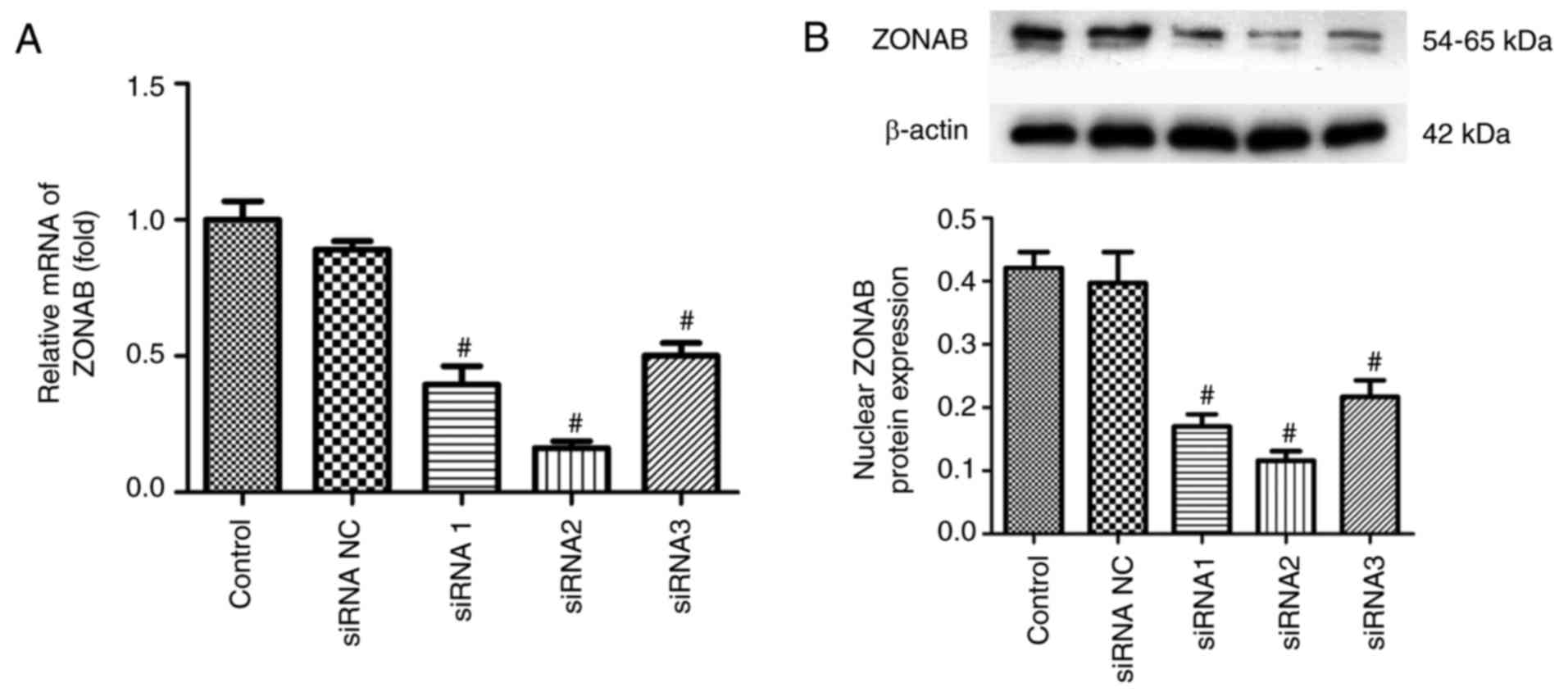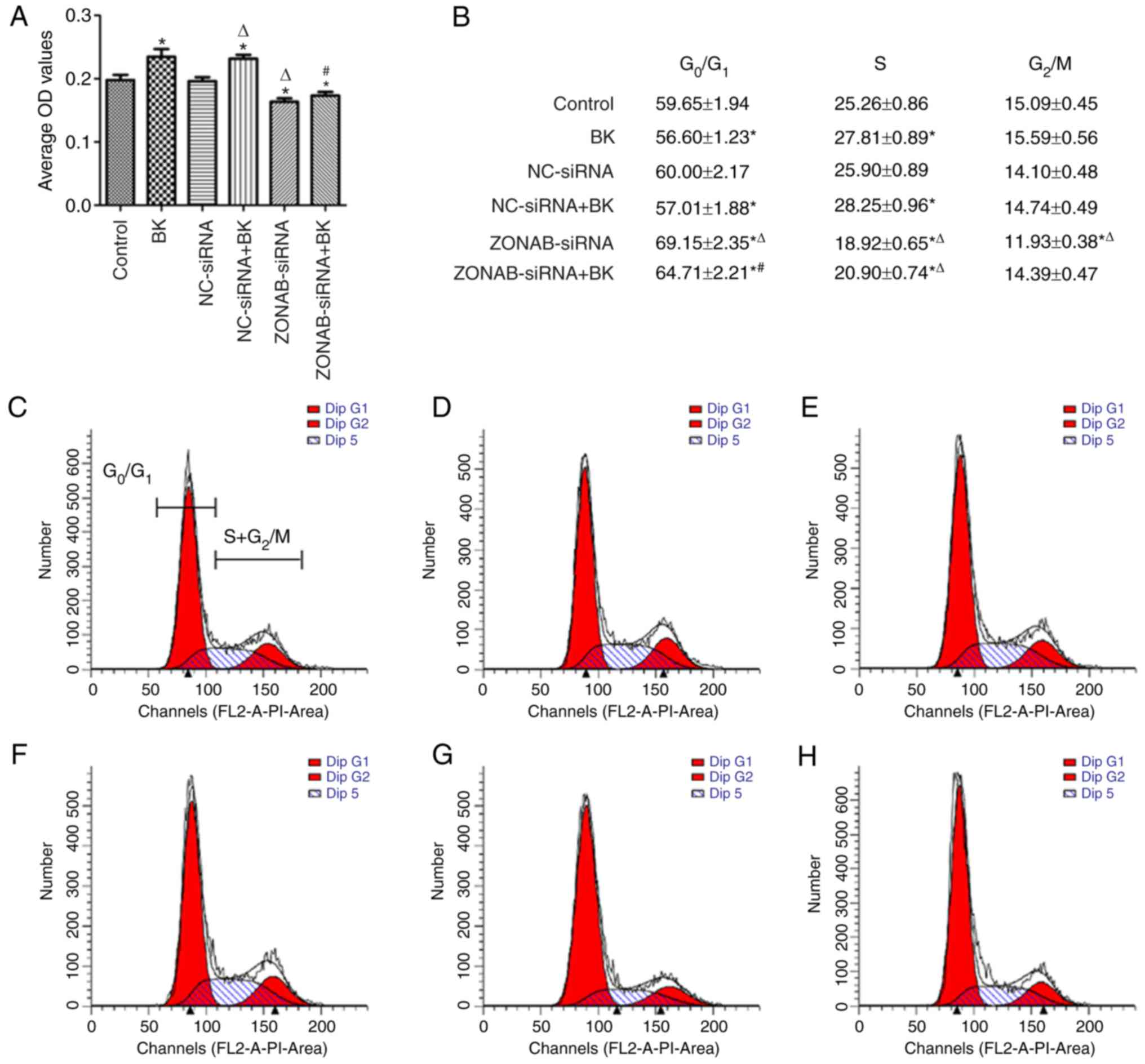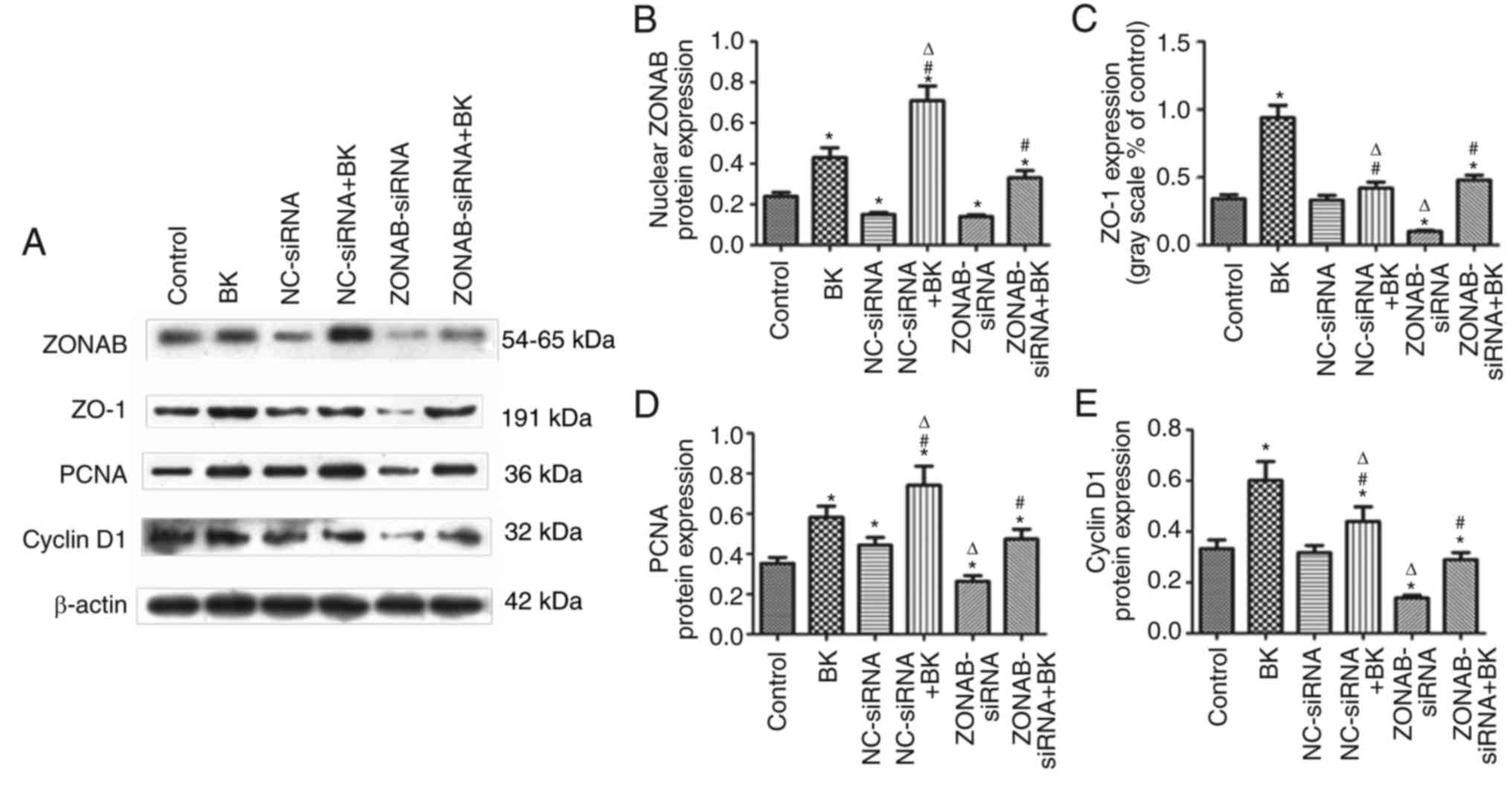|
1
|
Waring GO, Bourne WM, Edelhauser HF and
Kenyon KR: The corneal endothelium. Normal and pathologic structure
and function. Ophthalmology. 89:531–590. 1982. View Article : Google Scholar : PubMed/NCBI
|
|
2
|
Joyce NC: Proliferative capacity of the
corneal endothelium. Prog Retin Eye Res. 22:359–389. 2003.
View Article : Google Scholar : PubMed/NCBI
|
|
3
|
Bourne WM, Nelson LR and Hodge DO: Central
corneal endothelial cell changes over a ten-year period. Invest
Ophthalmol Vis Sci. 38:779–782. 1997.PubMed/NCBI
|
|
4
|
Saxena R, Boekhoorn SS, Mulder PG,
Noordzij B, van Rij G and Luyten GP: Long-term follow-up of
endothelial cell change after Artisan phakic intraocular lens
implantation. Ophthalmology. 115:608–613. 2008. View Article : Google Scholar
|
|
5
|
Kashuba E, Bailey J, Allsup D and Cawkwell
L: The kinin-kallikrein system: Physiological roles,
pathophysiology and its relationship to cancer biomarkers.
Biomarkers. 18:279–296. 2013. View Article : Google Scholar : PubMed/NCBI
|
|
6
|
Khan MM, Bradford HN, Isordia-Salas I, Liu
Y, Wu Y, Espinola RG, Ghebrehiwet B and Colman RW:
High-molecular-weight kininogen fragments stimulate the secretion
of cytokines and chemokines through uPAR, Mac-1, and gC1qR in
monocytes. Arterioscler Thromb Vasc Biol. 26:2260–2266. 2006.
View Article : Google Scholar : PubMed/NCBI
|
|
7
|
Levy D and Zochodne DW: Increased mRNA
expression of the B1 and B2 bradykinin receptors and
antinociceptive effects of their antagonists in an animal model of
neuropathic pain. Pain. 86:265–271. 2000. View Article : Google Scholar : PubMed/NCBI
|
|
8
|
Huang SC, Chien C, Hsiao L, Wang C, Chiu
C, Liang K and Yang CM: Mechanisms of bradykinin-mediated
Ca2+ signaling in canine cultured corneal epithelial
cells. CellSignal. 13:565–574. 2001.
|
|
9
|
Wiernas TK, Davis TL, Griffin BW and
Sharif NA: Effects of bradykinin on signal transduction, cell
proliferation, and cytokine, prostaglandin E2 and
collagenase-1 release from human corneal epithelial cells. Br J
Pharmacol. 123:1127–1137. 1998. View Article : Google Scholar : PubMed/NCBI
|
|
10
|
Cheng CY, Huang SC, Hsiao LD, Sun CC, Jou
MJ and Yang CM: Bradykinin-stimulated P42/44 MAPK activation
associated with cell proliferation in corneal keratocytes.
CellSignal. 16:535–549. 2004.
|
|
11
|
Cheng CY, Tseng HC and Yang CM:
Bradykinin-mediated cell proliferation depends on transactivation
of EGF receptor in corneal fibroblasts. J Cell Physiol.
227:1367–1381. 2012. View Article : Google Scholar
|
|
12
|
Yang SW, Lee WK, Lee EJ, Kim KY, Lim Y,
Lee KH, Rha HK and Hahn TW: Effect of bradykinin on cultured bovine
corneal endothelial cells. Ophthalmologica. 215:303–308. 2001.
View Article : Google Scholar : PubMed/NCBI
|
|
13
|
Webb JG: The kallikrein/kinin system in
ocular function. J Ocul Pharmacol Ther. 27:539–543. 2011.
View Article : Google Scholar : PubMed/NCBI
|
|
14
|
Balda MS and Matter K: Tight junctions and
the regulation of gene expression. Biochim Biophys Acta.
1788:761–767. 2009. View Article : Google Scholar : PubMed/NCBI
|
|
15
|
Terry S, Nie M, Matter K and Balda MS: Rho
signaling and tight junction functions. Physiology. 25:16–26. 2010.
View Article : Google Scholar : PubMed/NCBI
|
|
16
|
Balda MS and Matter K: The tight junction
protein ZO-1 and an interacting transcription factor regulate
ErbB-2 expression. EMBO J. 19:2024–2033. 2000. View Article : Google Scholar : PubMed/NCBI
|
|
17
|
Balda MS, Garrett MD and Matter K: The
ZO-1-associated Y-box factor ZONAB regulates epithelial cell
proliferation and cell density. J Cell Bio1. 160:423–432. 2003.
View Article : Google Scholar
|
|
18
|
Lima WR, Parreira KS, Devuyst O, Caplanusi
A, N'kuli F, Marien B, Van Der Smissen P, Alves PM, Verroust P,
Christensen EI, et al: ZONAB promotes proliferation and represses
differentiation of proximal tubule epithelial cells. J Am Soc
Nephrol. 21:478–488. 2010. View Article : Google Scholar : PubMed/NCBI
|
|
19
|
Sourisseau T, Georgiadis A, Tsapara A, Ali
RR, Pestell R, Matter K and Balda MS: Regulation of PCNA and cyclin
D1 expression and epithelial morphogenesis by the ZO-1-regulated
transcription factor ZONAB/DbpA. Mol Cell Biol. 26:2387–2398. 2006.
View Article : Google Scholar : PubMed/NCBI
|
|
20
|
Georgiadis A, Tschemutter M, Bainbridge
JW, Balaggan KS, Mowat F, West EL, Munro PM, Thrasher AJ, Matter K,
Balda MS, et al: The tight junction associated signaling proteins
ZO-1 and ZONAB regulate retinal pigment epithelium homeostasis in
mice. PloS One. 5:e157302010. View Article : Google Scholar
|
|
21
|
U.S. Office of Science and Technology
Policy: Technology, Laboratory animal welfare: U.S. government
principles for the utilization andcare of vertebrate animals used
in testing, research and training; notice. Fed Regist.
50:20864–20865. 1985.
|
|
22
|
Kay P, Nimni ME and Smith RE: Stability of
collagen phenotype in morphologically modulated rabbit corneal
endothelial cells. Invest Ophthalmol Vis Sci. 25:495–501.
1984.PubMed/NCBI
|
|
23
|
Kim TY, Kim WI, Smith RE and Kay ED: Role
of p27Kip1 in cAMP- and TGF-β2-mediated
antiproliferation in rabbit corneal endothelial cells. Invest
Ophthalmol Vis Sci. 42:3142–3149. 2001.PubMed/NCBI
|
|
24
|
Schäfer J, Höbel S, Bakowsky U and Aigner
A: Liposome-polyethylenimine complexes for enhanced DNA and siRNA
delivery. Biomaterials. 31:6892–6900. 2010. View Article : Google Scholar : PubMed/NCBI
|
|
25
|
Park SY, Jeong MS, Han CW, Yu HS and Jang
SB: Structural and functional insight into proliferating cell
nuclear antigen. J Microbiol Biotechnol. 28:637–647. 2016.
View Article : Google Scholar
|
|
26
|
Qie S and Diehl JA: Cyclin D1, cancer
progression, and opportunities in cancer treatment. J Mol Med).
94:1313–1326. 2016. View Article : Google Scholar
|
|
27
|
Wiernas TK, Griffin BW and Sharif NA: The
expression of functionally-coupled B2-bradykinin
receptors in human corneal epithelial cells and their
pharmacological characterization with agonists and antagonists. Br
J Pharmacol. 121:649–656. 1997. View Article : Google Scholar : PubMed/NCBI
|
|
28
|
Kuznetsova TP, Chesnokova NB and Paskhina
TS: Activity of tissue and plasma kallikrein and level of their
precursors in eye tissue structures and media of healthy rabbits.
Vopr Med Khim. 37:79–82. 1991.In Russian. PubMed/NCBI
|
|
29
|
Ma JX, Song Q, Hatcher HC, Crouch RK, Chao
L and Chao J: Expression and cellular localization of the
kallikrein-kinin system in human ocular tissues. Exp Eye Res.
63:19–26. 1996. View Article : Google Scholar : PubMed/NCBI
|
|
30
|
Leeb-Lundberg LM: Bradykinin specificity
and signaling at GPR100 and B2 kinin receptors. Br J Pharmacol.
143:931–932. 2004. View Article : Google Scholar : PubMed/NCBI
|
|
31
|
Dixon BS, Sharma RV, Dickerson T and
Fortune J: Bradykinin and angiotensin II: Activation of protein
kinase C in arterial smooth muscle. Am J Physiol. 266:C1406–1420.
1994. View Article : Google Scholar : PubMed/NCBI
|
|
32
|
Mio T, Liu X, Toews ML, Adachi Y,
Romberger DJ, Spurzem JR and Rennard SI: Bradykinin augments
fibroblast-mediated contraction of released collagen gels. Am J
Physiol Lung Cell Mol Physiol. 281:L164–L171. 2001. View Article : Google Scholar : PubMed/NCBI
|
|
33
|
Bernier SG, Haldar S and Michel T:
Bradykinin-regulated interactions of the mitogen-activated protein
kinase pathway with the endothelial nitric-oxide synthase. J Biol
Chem. 275:30707–30715. 2000. View Article : Google Scholar : PubMed/NCBI
|
|
34
|
Yang CM, Lin MI, Hsieh HL, Sun CC, Ma YH
and Hsiao LD: Bradykinin-induced p42/44 MAPK phosphorylation and
cell proliferation via Src, EGF receptors, and PI3-K/Akt in
vascular smooth muscle cells. J Cell Physiol. 203:538–546. 2005.
View Article : Google Scholar
|
|
35
|
Arakawa Y, Kajino K, Kano S, Tobita H,
Hayashi J, Yasen M, Moriyama M, Arakawa Y and Hino O: Transcription
of dbpA, a Y box binding protein, is positively regulated by E2F1:
Implications in hepatocarcinogenesis. Biochem Biophys Res Commun.
322:297–302. 2004. View Article : Google Scholar : PubMed/NCBI
|
|
36
|
Jayagopal A, Yang JL, Haselton FR and
Chang MS: Tight junction-associated signaling pathways modulate
cell proliferation in uveal melanoma. Invest Ophthalmol Vis Sci.
52:588–593. 2011. View Article : Google Scholar :
|
|
37
|
Kampik D, Basche M, Georgiadis A, Luhmann
UF, Smith AJ, Larkin F and Ali RR: Lentivirus mediated interference
with the ZO-1/ZONAB pathway induces cell cycle progression in human
corneal endothelial cells. Invest Ophthalmol Vis Sci.
53:60042012.
|
|
38
|
Spadaro D, Tapia R, Jond L, Sudol M,
Fanning AS and Citi S: ZO proteins redundantly regulate the
transcription factor DbpA/ZONAB. J Biol Chem. 289:22500–22511.
2014. View Article : Google Scholar : PubMed/NCBI
|
|
39
|
Qiao X, Roth I, Féraille E and Hasler U:
Different effects of ZO-1, ZO-2 and ZO-3 silencing on kidney
collecting duct principal cell proliferation and adhesion. Cell
Cycle. 13:3059–3075. 2014. View Article : Google Scholar
|
|
40
|
Willott E, Balda MS, Fanning AS, Jameson
B, Van Itallie C and Anderson JM: The tight junction protein ZO-1
is homologous to the Drosophila discs-large tumor suppressor
protein of septate junctions. Proc Natl Acad Sci USA. 90:7834–7838.
1993. View Article : Google Scholar : PubMed/NCBI
|



